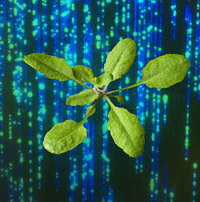
New Technologies Show Better Details on GM Plants
January 23, 2019| |
 Researchers from the Salk Institute used the latest DNA sequencing technologies to study exactly what happens at a molecular level when new genes are inserted into plants. Scientists usually rely on Agrobacterium tumefaciens when they want to put a new gene into a plant. Decades ago, scientists discovered that when the bacteria infected a tree, it transferred some of its DNA to the tree's genome. Since then, researchers have co-opted this transfer ability of Agrobacterium for their own purposes, using its transfer-DNA (T-DNA) to move a desired gene into a plant. Recently, DNA sequencing technologies started to hint that when the Agrobacterium T-DNA is used to insert new genes into a plant, it may cause additional changes to the structural and chemical properties of the native DNA.
Researchers from the Salk Institute used the latest DNA sequencing technologies to study exactly what happens at a molecular level when new genes are inserted into plants. Scientists usually rely on Agrobacterium tumefaciens when they want to put a new gene into a plant. Decades ago, scientists discovered that when the bacteria infected a tree, it transferred some of its DNA to the tree's genome. Since then, researchers have co-opted this transfer ability of Agrobacterium for their own purposes, using its transfer-DNA (T-DNA) to move a desired gene into a plant. Recently, DNA sequencing technologies started to hint that when the Agrobacterium T-DNA is used to insert new genes into a plant, it may cause additional changes to the structural and chemical properties of the native DNA.
Since the T-DNA approach can lead to an integration of many copies of a desired gene into a plant, it can be difficult to study the final result with standard DNA sequencing. Joseph Ecker, a professor in Salk's Plant Molecular and Cellular Biology Laboratory and head of the Genomic Analysis Laboratory and his colleagues turned to a new combination of approaches. These include optical mapping and nanopore sequencing. They applied the technologies to four randomly selected T-DNA lines of Arabidopsis thaliana, a commonly used model plant in biology.
Optical mapping revealed that the plants had between one and seven distinct insertions or rearrangements in their genomes. Nanopore sequencing and reconstruction of the genomes of two lines confirmed the insertions to single-letter resolution. Gene insertions themselves showed a variety of patterns, with the inserted DNA fragment sometimes scrambled, inverted or even silenced.
For more details, read the article in Salk News.
| |
Biotech Updates is a weekly newsletter of ISAAA, a not-for-profit organization. It is distributed for free to over 22,000 subscribers worldwide to inform them about the key developments in biosciences, especially in biotechnology. Your support will help us in our mission to feed the world with knowledge. You can help by donating as little as $10.
-
See more articles:
-
News from Around the World
- IRRI Recognized for Excellence in Transgenic Research Management
- Nigeria Moves Forward to Bt Cowpea Commercialization
- 58-Year-Old Corn Gene Mystery Unraveled
- New Technologies Show Better Details on GM Plants
- World Vegetable Center Looks into Wild Relatives of Eggplant for Food Security
- India's Top Government Agencies Team Up to Strengthen Agri-biotech Research and Education
- Stakeholders in the Philippines Briefed on Science-based Framework for Regulation of Breeding Stacks
- EuropaBio Secretary General Says Europe Needs Proportionate, Fit-for-Purpose, and Science-based Approach to Modern Technologies
-
Research Highlights
- Genetic Transformation of Maize with Drought-responsive OsNAC45 Gene
- Study Shows Drought Tolerant HB4 Wheat Compositionally Equivalent to Non-GM Wheat
-
Beyond Crop Biotech
- Forest Biotechnologists Call for Review of Restrictive Policies Regarding Biotech Research
- Scientists Develop New CRISPR Platform for DNA Targeting
-
Announcements
- Cornell Alliance for Science 2019 Global Leadership Fellows Program
-
Plant
- Agrobacterium-mediated Delivery of the CRISPR/Cas9 System in Tomato
- John Innes Centre Applies for GM Wheat, CRISPR Brassica Field Trials
-
Read the latest: - Biotech Updates (November 12, 2025)
- Gene Editing Supplement (October 29, 2025)
- Gene Drive Supplement (February 22, 2023)
-
Subscribe to BU: - Share
- Tweet
